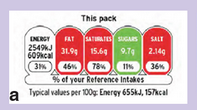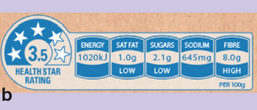
Food Safety Focus (121st Issue, August 2016) – Food Safety Platform
Nutrient Profiling and its Application
Reported by Mr. Nicky HO, Scientific Officer,
Risk Assessment Section,
Centre for Food Safety
There is a growing interest around the world to reduce the disease burden of non-communicable diseases (NCD) such as cardiovascular diseases and hypertension. Reducing the risk from unhealthy diet is one of the key focus areas of the World Health Organization (WHO) to prevent deaths from NCD. Overseas authorities have started to develop nutrient profiling for the development of norms and regulations for unhealthy foods. This article talks about nutrient profiling and its applications.
Nutrient Profiling
Nutrient profiling is the science of classifying or ranking foods according to their nutritional compositions for reasons related to preventing disease and promoting health. It is a scientific method for assessing the nutritional quality of foods.
There are two main groups of nutrient profile model. One generates descriptions referring to the nutrient levels in foods (e.g. high sugars, high sodium) while the other generates descriptions referring to the effects of consuming the foods on a person's health (e.g. healthy, healthy option).
 |
 |
 |
|---|
- Traffic light labelling system
(Source: UK Department of Health) - Health Star Rating system
(Source: Commonwealth of Australia) - Keyhole labelling scheme
(Source: National Food Agency, Sweden)
Development of Nutrient Profile Model
The WHO has been working with international experts and partners to provide guidance in developing or adapting nutrient profile models. In the report of a technical meeting held in 2010, it provided a step-by-step process for planning the development of a nutrient profile model.
Nutrients and Food Components Involved in Nutrient Profiling
The nutrients involved in nutrient profiling generally depend on the evidence relating nutrient intakes to public health outcomes. So, nutrients that are associated with increasing risk for chronic diseases, such as sodium, sugar, saturated fat and trans fat are always involved. Moreover, nutrients that are good for our health, such as protein and dietary fibre may sometimes be taken into account in order to provide a more complete picture on the nutritional quality of foods.
Other than nutrients, food components like ingredients (such as fruits, nuts and legumes) and food additives (such as sweetener) may also be involved in nutrient profiling based on the dietary guidelines and recommendations in the regions or countries.
Nutrition profiling usually classifies or ranks foods by means of scoring or/and thresholds based on the contents of nutrients or/and food components.
Application of Nutrient Profiling
Nutrient profiling can be used for various applications. It is commonly used in food labelling schemes aimed at helping consumers better understand the nutrient composition of foods and identify foods that are healthier options. It can also be used in implementing the recommendations on the marketing of foods to children.
Overseas countries have started to develop various nutrient profile models for different applications.
In the United Kingdom, the traffic light labelling system ranks fat, saturated fat, sugar and salt of a food product by assigning the colour green, amber and red according to the content levels. In addition, food products that exceed specified levels of fat, salt and sugar cannot be advertised in television programmes commissioned for audiences below the age of 16.
In Australia, the Health Star Rating system rates food products from ½ a star to 5 stars, based on their nutrient contents (i.e. energy, saturated fat, sugar, and sodium, and in some instances, protein, calcium and dietary fibre) and ingredient information (i.e. fruits, vegetables, nuts and legumes). The more stars, the healthier the choice.
In some Nordic countries, the Keyhole labelling scheme identifies healthy foods within a product group, based on the criteria relating to dietary fibre, salt, sugar, fat, and saturated fat.
In Hong Kong, the Nutrition Labelling Scheme covers nutrition labelling and nutrition claims on general prepackaged foods. It requires information on energy and seven specified nutrients to be listed on food labels and regulates nutrition claims (such as low fat, high calcium), so as to assist consumers in making informed food choices.
Improve Diet and Promote Public Health
Although nutrient profiling does not address all aspects of nutrition, diet and health, it is a helpful tool to use in conjunction with interventions aimed at improving diets. Nutrient profile models classify foods based on their nutrient composition and the information can be used to help in achieving dietary recommendation. So, nutrient profile models need to complement and support food-based dietary guidelines in the regions or countries in which they are applied.


